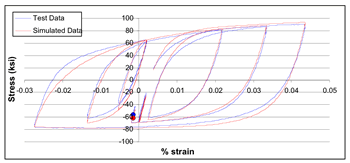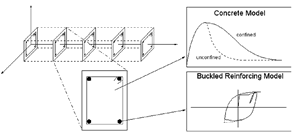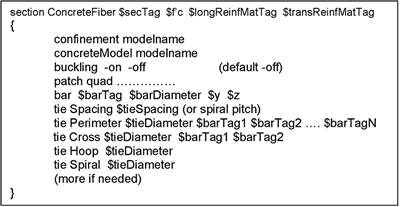Review of Existing Material Models
In general, recent material models developed
to simulate the response of mild reinforcing steel tend to be different
variations of a bounding surface
type formulation. A comprehensive review of different material model formulations
was carried out. The most popular implementations appear to be derived
from a Menegotto-Pinto formulation used to simulate kinematic hardening
under cyclic loading. Dafalias has proposed a more classical bounding
surface model capable of modeling both isotropic and kinematic hardening.
This model has been developed in a general formulation that allows for
the consideration of stress in a 3-d continuum. Balan and Filippou have
also proposed a model based on the Menegotto-Pinto formulation, however
it uses a slightly different formulation for the kinematic hardening term.
The Chang-Mander model, which appeared to be the best-developed model
based on the Menegotto-Pinto formulation, was eventually selected as the
base model for the proposed development.
Material Model Implementation
The Chang-Mander model was selected because it was well developed and
offered good control over the reinforcing bar behavior. Concepts presented
in the
Balan-Filippou model were used to relate the compressive monotonic curve
to the tensile monotonic curve. The implementation of the current model
is easy to use, and fairly accurate results can be obtained by specifying
only the yield stress, ultimate stress, and the hardening strain. The
model was validated with both constant amplitude reversal tests and
random cyclic
events with generally good agreement with experimental results as shown
in Figure 1.
It was noted, however, that after the peak, the model exhibited a tendency to over predict the stress in the reinforcing steel, which is common to bounding surface models. To overcome this, additional memory parameters were added to the original Chang-Mander model. By including 16 reversal memory locations rather than 10, the model is now able to perform very well through an entire random cyclic event as demonstrated in Figure 1. Another feature of the material model is the incorporation of fatigue and strength degradation using an accumulated equivalent cyclic stain counting relationship based on low-cycle fatigue tests of reinforcing bars conducted by Brown and Kunnath.
Work in Progress
Reinforcing Buckling Model
The concrete fiber section object creates a fiber section object. The properties of the concrete material depend on the particular confinement model selected and the unconfined compressive strength of the concrete. The confinement model determines the effective confinement based on the tie configuration provided. If no ties are provided, the section is assumed to be unconfined. The tie spacing also dictates the buckling behavior of the reinforcing bars.
confinement command
This command is used to select a confinement model
to be used on the cross-section. During model calibration, several confinement
models may by implemented and compared.
concreteModel command
This command is used to select the concrete model used on the cross-section.
Because of its dependency on the confinement model, the concrete
material model must be created by the fiber section.
buckling command
This command is used to toggle buckling behavior on or off.
patch
This command is used similar to the fiber section patch only no material
tag is assigned. This will require additional consideration during implementation.
The goal is to provide the overall size of the section and its discretization
in the core and cover. The Concrete Section command will then create
the required patches and assign the appropriate confinement models
to them.


